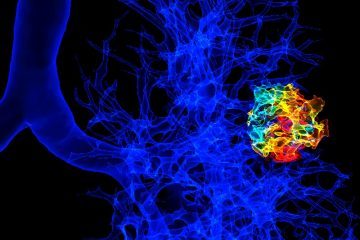Charles Swanton in Nature:
 Before the COVID-19 pandemic, the TRACERx project had recruited 760 people with early-stage lung cancer. After a person is diagnosed with a primary lung tumour, it is surgically removed and the cells are analysed to reconstruct the tumour’s evolutionary history. Each individual receives a computed tomography (CT) scan every year for five years to check whether their cancer has returned. If there is no sign of relapse, they are discharged and deemed to have been cured. People with later-stage tumours (stages 2 and 3) are offered chemotherapy following surgery to improve the chance of remission or cure.
Before the COVID-19 pandemic, the TRACERx project had recruited 760 people with early-stage lung cancer. After a person is diagnosed with a primary lung tumour, it is surgically removed and the cells are analysed to reconstruct the tumour’s evolutionary history. Each individual receives a computed tomography (CT) scan every year for five years to check whether their cancer has returned. If there is no sign of relapse, they are discharged and deemed to have been cured. People with later-stage tumours (stages 2 and 3) are offered chemotherapy following surgery to improve the chance of remission or cure.
Analysis of tumours from the first 100 people enrolled in the study has revealed many genomic changes. These include chromosome deletions and duplications, and even the doubling of whole genomes in nearly three-quarters of tumours — a feature of many cancers1. Point mutations in DNA, arising from single changes in the genome sequence, were also prevalent. These occurred as a result of tobacco exposure and the activity of enzymes called cytidine deaminases, which normally deactivate invading viruses as part of the immune response. Another finding is that whole-genome doubling often occurs early on in those with lung cancer who have a history of smoking1. This doubling seems to protect the genes needed for the tumour’s survival in the face of the excessive mutations and chromosomal losses that occur in its genome as it develops2. Strikingly, mutations induced by smoking tend to dominate the ‘trunk’ of the tumour’s evolutionary tree. These are known as founder or truncal mutations, and are present in every tumour cell. For the most common type of non-small-cell lung cancer — adenocarcinomas that form in mucus-secreting glands — the number of smoking-related mutations in the trunk correlates with the number of cigarettes that the person has smoked. As the cancer advances, cytidine deaminases cause haphazard mutations to accumulate in some cells; we refer to these as branched mutations2.
With a view to devising immunotherapy3, we also investigated the DNA sequences of receptors on T cells, a type of white blood cell that fights off infection and emerging cancers. We were surprised to discover that the sequences of T-cell receptors evolved in parallel with the tumour.
…The overriding message is that it will take multiple approaches to outpace cancers that have sophisticated evolutionary mechanisms, such as lung cancer. Each approach will have to focus on different stages of the disease to improve outcomes.
More here.
